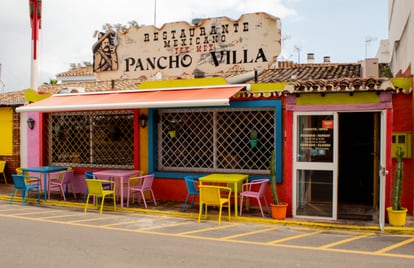Don Diego Mancera (Cádiz, 1957) usually serves his special sauce with a dropper. Taking it by the spoonful would be dangerous. This Andalusian, so cheerful and cordial to the treatment, prepares the spiciest sauce in the world, or at least, that's what his customers say. This unique reddish-black liquid, with an oily appearance, and a pungent odor that could instantly unclog any congested nose, is the star ingredient of his restaurant, Pancho Villa (Av. Jábega 78b, Saladillo, Málaga), a Mexican cuisine establishment that Mancera and his family founded more than 20 years ago.
To prepare this elixir worthy of the Tlatlauhqui-cihuatl, the Aztec goddess of chili, a minimum of two months is required. The preparation of this dressing is a ritual for Mancera. He himself harvests his own habanero, jalapeño, Trinidad Scorpion and Carolina Reaper peppers, (classified as the hottest in the world according to the 2013 Guinness Book), in a garden near his restaurant. “I bought the chili seeds on a specialized website, since it is difficult to find them in Spain. I went to a nursery to get help to plant them in some pots and to put down roots to later plant them in the ground ”, he explains to ICON.
After several weeks of harvest, and after dehydrating the peppers with special machinery, he crushes them and soaks them for a month in a kind of "neutral alcohol", as he calls it.
"Every day we move the mixture until little by little it changes color: from light red to almost black," says Mancera.
As that alcohol evaporates, only the chili extract remains that his son and Pancho Villa's cook, Wayne Mancera, helps him place in small microdosing jars.
"My goal with this sauce is to include it in the dishes to make Mexican food as authentic as possible, a very complex and extensive gastronomy."
This unique reddish-black liquid, with an oily appearance, and a pungent odor, is placed in micro-dose bottles.
This type of chili extracts are called Capsaicin, and on the internet they cost between 50 and 80 euros for 20 grams. This precious active ingredient in peppers produces a strong burning sensation in the mouth. With the Scoville scale, developed in 1912 by the American pharmacologist Wilbur Scoville, the degree of itching of Capsaicin in chillies is measured; and curiously, those grown by Don Diego are among the five hottest in the world, according to the Scoville table. "We put the sauce in microdosing jars so that customers do not get hurt, you have to enjoy it, and you can't take a spoonful," says the man from Cádiz.
Don Diego learned the Mexican culinary art on a trip to Mexico when he was 28 years old, however, to get to the Aztec country, he first experimented with other types of gastronomy. Don Diego, born in Spain but raised in England, decided to try his luck in the United States in his youth. That's where he started preparing
Tex-Mex
food.
in a restaurant in Detroit, Michigan, but not satisfied with the type of food he made, he moved to Mexico City.
“I moved to the nearby towns of the capital, I loved to eat with the families, they taught me to cook: from simple dishes to complex meals prepared with banana leaves and grilled in an underground oven, such as the cochinita pibil [a traditional food made with marinated pork that is very popular in southeastern Mexico] ”, he explains.
Pancho Villa, a Mexican restaurant that Don Diego and his family founded more than 20 years ago in Saladillo, Malaga.
After spending two years in Mexico, Don Diego chose to return to Spain. "After living practically all my life abroad, for me everything was a novelty on the Costa del Sol," he recalls. At first he opened a restaurant in the town of Estepona with his American partner, then he moved to another establishment in Puerto Banús, where he spent more than eight years, and finally founded his own family business in the town of El Saladillo. There he makes a wide variety of Mexican food: tacos, enchiladas, quesadillas, stuffed chiles, Aztec soup, chimichangas, grilled meats and alcoholic beverages that include coffee and chocolate.
Despite preparing many authentic Mexican dishes, its most appreciated specialty is its unique chili extract, a product that it began to make about five years ago.
He argues that his most loyal customers asked him for increasingly spicy products even though some of them ended up in the hospital for underestimating the power of his chili peppers.
“Some time ago, a Spanish boy, the husband of a Mexican client of mine, ate some of my peppers, after a few seconds he began to cry.
It was so spicy for him that he couldn't take it, and he needed medical assistance ”, he shares with some grace.
Curiously, this sauce has no name, however, there is no one who has tried it who forgets it.
Canned jalapeño peppers that the chef himself harvests and sells in his restaurant.mariana galvez
THE 10 SPICY CHILLIES IN THE WORLD
Capsaicin is the substance responsible for the heat of chili peppers.
On the Scoville scale, this chemical compound in its pure state has up to 16,000,000 SHU.
These are the 10 hottest peppers in the world:
1. Carolina Reaper.
Originally from South Carolina, it has between 1,150,000 and 2,220,000 SHUs.
2. Trinidad Moruga Scorpion.
Originally from Trinidad and Tobago, it has between 1,200,000 and 2,009,231 SHU.
3. Trinidad Scorpion Butch T. Between 500,000 and 1,463,700 SHU.
4. Naga Jolokia.
Originally from India, it dials between 855,000 and 1,041,427 SHU.
5. Savina Red Habanero.
Grown in Mexico and Peru, it has between 580,000 and 350,000 SHU.
6. Habanero, Jamaica, Scottish hat.
They all have between 100,000 and 350,000 SHUs.
7. Chiltepín, Piquín and Thai.
Between 50,000 and 100,000 SHU.
8. Cayenne pepper.
Between 30,000 and 50,000 SHU.
9. Serrano and Chipotle.
Very used in Mexico, it has between 10,000 and 23,000 SHU.
10. Jalapeño and Guajillo.
Between 3,500 and 8,000 SHU.
You can follow ICON on
,
,
, or subscribe here to the
Newsletter
.


/cloudfront-eu-central-1.images.arcpublishing.com/prisa/MN37VSL3FNG7NIKWVLIW6PTTPI.jpg)
/cloudfront-eu-central-1.images.arcpublishing.com/prisa/AFLYZDTUIJETROGK67SU5F4OOA.jpg)

/cloudfront-eu-central-1.images.arcpublishing.com/prisa/UNSQPE5JMU4IHNC7OAJZPVJKAU.jpg)


/cloudfront-eu-central-1.images.arcpublishing.com/prisa/SR636FOCPVBILPCXVP6SLZ5ME4.jpg)
